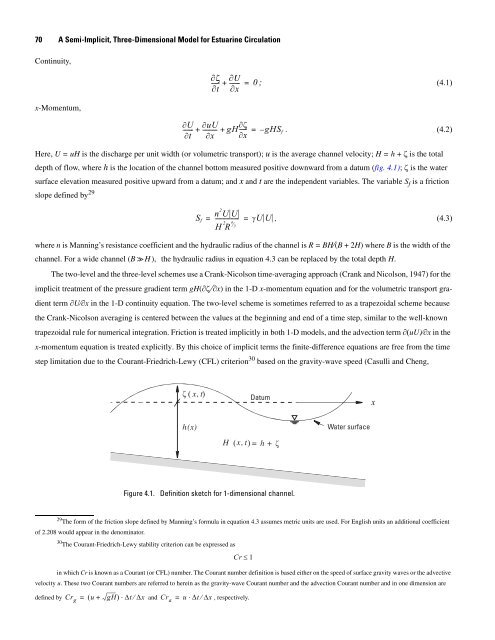A Semi-Implicit, Three-Dimensional Model for Estuarine ... - USGS
A Semi-Implicit, Three-Dimensional Model for Estuarine ... - USGS
A Semi-Implicit, Three-Dimensional Model for Estuarine ... - USGS
You also want an ePaper? Increase the reach of your titles
YUMPU automatically turns print PDFs into web optimized ePapers that Google loves.
70 A <strong>Semi</strong>-<strong>Implicit</strong>, <strong>Three</strong>-<strong>Dimensional</strong> <strong>Model</strong> <strong>for</strong> <strong>Estuarine</strong> Circulation<br />
Continuity,<br />
x-Momentum,<br />
∂U<br />
-------<br />
∂t<br />
∂ζ<br />
------<br />
∂t<br />
∂U<br />
+ ------- = 0 ; (4.1)<br />
∂x<br />
∂uU<br />
---------- gH<br />
∂x<br />
∂ζ<br />
+ + ----- = – gHSf .<br />
(4.2)<br />
∂x<br />
Here, U = uH is the discharge per unit width (or volumetric transport); u is the average channel velocity; H = h + ζ is the total<br />
depth of flow, where h is the location of the channel bottom measured positive downward from a datum (fig. 4.1); ζ is the water<br />
surface elevation measured positive upward from a datum; and x and t are the independent variables. The variable Sf is a friction<br />
slope defined by 29<br />
S f<br />
n 2 UU<br />
= ----------------- = γU U , (4.3)<br />
H 2<br />
R 4 ⁄ 3<br />
where n is Manning’s resistance coefficient and the hydraulic radius of the channel is R = BH⁄(B + 2H) where B is the width of the<br />
channel. For a wide channel (B >> H ), the hydraulic radius in equation 4.3 can be replaced by the total depth H.<br />
The two-level and the three-level schemes use a Crank-Nicolson time-averaging approach (Crank and Nicolson, 1947) <strong>for</strong> the<br />
implicit treatment of the pressure gradient term gH(∂ζ ⁄∂x) in the 1-D x-momentum equation and <strong>for</strong> the volumetric transport gra-<br />
dient term ∂U⁄∂x in the 1-D continuity equation. The two-level scheme is sometimes referred to as a trapezoidal scheme because<br />
the Crank-Nicolson averaging is centered between the values at the beginning and end of a time step, similar to the well-known<br />
trapezoidal rule <strong>for</strong> numerical integration. Friction is treated implicitly in both 1-D models, and the advection term ∂(uU)⁄∂x in the<br />
x-momentum equation is treated explicitly. By this choice of implicit terms the finite-difference equations are free from the time<br />
step limitation due to the Courant-Friedrich-Lewy (CFL) criterion 30 based on the gravity-wave speed (Casulli and Cheng,<br />
ζ ( x, t)<br />
h(x)<br />
Figure 4.1. Definition sketch <strong>for</strong> 1-dimensional channel.<br />
29 The <strong>for</strong>m of the friction slope defined by Manning’s <strong>for</strong>mula in equation 4.3 assumes metric units are used. For English units an additional coefficient<br />
of 2.208 would appear in the denominator.<br />
30The Courant-Friedrich-Lewy stability criterion can be expressed as<br />
H ( x, t)<br />
= h + ζ<br />
Cr ≤ 1<br />
in which Cr is known as a Courant (or CFL) number. The Courant number definition is based either on the speed of surface gravity waves or the advective<br />
velocity u. These two Courant numbers are referred to herein as the gravity-wave Courant number and the advection Courant number and in one dimension are<br />
defined by Crg = ( u + gH)<br />
⋅ Δt⁄ Δx and Cra = u ⋅ Δt ⁄ Δx,<br />
respectively.<br />
/<br />
Datum<br />
Water surface<br />
x

















